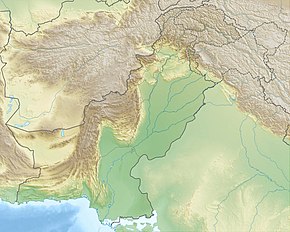
Back معركة السند Arabic سند دؤیوشو AZB Batalla del Indo Spanish جنگ سند Persian Pertempuran Indus ID インダス河畔の戦い Japanese Perang Sungai Indus Malay Bitwa nad brzegami Indusu Polish انڈس دی لڑائی PNB Битва на реке Инд (1221) Russian
| Battle of the Indus | |||||||||
|---|---|---|---|---|---|---|---|---|---|
| Part of the Mongol conquest of the Khwarazmian Empire | |||||||||
 Late 16th-century depiction of Jalal al-Din fleeing the battle by crossing the Indus; Genghis Khan looks on. | |||||||||
| |||||||||
| Belligerents | |||||||||
| Mongol Empire | Khwarazmian Empire | ||||||||
| Commanders and leaders | |||||||||
|
Genghis Khan Chagatai Khan Ögedei Khan |
Jalal al-Din Mingburnu Amin Malik † Temur Malik † | ||||||||
| Strength | |||||||||
| 50,000 cavalry[1] |
3,000 cavalry with 700 bodyguards [1] with 30,000–35,000 semi-irregular men[2] | ||||||||
| Casualties and losses | |||||||||
| unknown | Heavy | ||||||||
Location within South Asia | |||||||||
The Battle of the Indus was fought on the banks of the Indus River, on 24 November 1221, by two armies commanded by Shah Jalal al-Din Mingburnu of the Khwarazmian Empire, and Genghis Khan of the Mongol Empire. The battle, which resulted in an overwhelming Mongol victory, was the concluding engagement in the Mongol conquest of the Khwarazmian Empire.
After his father Muhammad II had died on an island in the Caspian Sea, Jalal al-Din assumed the title of Khwarazmshah and travelled eastwards. Escaping the Mongols several times, he reached Ghazni and started assembling a large force; he then defeated the Mongol commander Shigi Qutuqu at the Battle of Parwan. This upset victory drew the attention and ire of Genghis Khan, who gathered a force of at least 50,000 and moved towards the Shah, who had lost a large proportion of his force because of a dispute over plunder. Now unable to effectively combat the Khan, he retreated eastwards towards the Indus river; the Mongols caught up on the morning the Khwarazmians were due to cross.
The Shah's army, now numbering around 30,000, assumed a strong defensive position on the banks of the river. They acquitted themselves well in the early fighting, managing to drive back the Mongol forces despite being heavily outnumbered. However, after an elite Mongol detachment managed to outflank the Khwarazmians, the Shah realized the battle was lost; in full armour, he rode his horse off a cliff into the Indus. As a mark of respect for his enemy's bravery, the Khan ordered his archers not to fire, and so the Shah managed to gain the opposite bank; however, his family and nearly all his army were slaughtered.
- ^ a b Sverdrup 2010, pp. 109–117.
- ^ Dupuy & Dupuy 1993, p. 366.
© MMXXIII Rich X Search. We shall prevail. All rights reserved. Rich X Search

